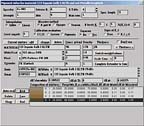Color Technology and Today’s High Performance/Cost Containment Conundrum

In today’s tough business markets, coatings manufacturers as well as pigment suppliers are squeezed by conflicting demands. On the one hand, the industry must keep pace with customer requests for increasingly high quality products, particularly the latest coatings that sell that contain metallic-flake, pearlescent and other effect pigments. On the other hand, the need to keep costs low is an absolute reality faced by suppliers and OEMs alike.
This article discusses the supply-chain implications of today’s market for the coatings industry, specifically as they affect color formulation. The article also covers the latest technological advances available to help both suppliers and OEMs cost-effectively support the new high-end colors in such demand today.

Competing with Color
Current competitive production environments require the highest standards of consistency and performance characteristics. Today’s customers require much more than an assurance of general acceptability in a delivered product; they require that coatings fall within a tight range of exacting specifications and guidelines.Nowhere are the challenges greater in meeting these heightened quality standards than in the area of color. Color is often the first, best test of quality, as well as an overwhelming sales impetus. The aesthetic appeal of a product -- communicated through color -- is one of the primary drivers of consumer choice. As metallic and pearlescent finishes play an increasingly important part in producing products that consumers want, more manufacturers and designers are turning to special-effect pigments to capture discerning, high-end buyers. But substantial challenges exist when it comes to color matching these special coatings.
The goal, of course, is to be on-target and on-color without the need for correction. Yet, how often have hours of production time been spent bringing batches on shade with even “standard” pigments?

High-End Challenges
The reasons for costly delays in color matching and manufacturing, of course, often lie in the real-world variables that make up colorant conditions. Is the sample you’ve been given to match flat or curved, glossy or matte finished, smooth or textured? Under what conditions has the sample been selected and viewed to match? Different gloss levels between batch and standard can easily translate into expensive rejections, particularly in darker colors. There is the consideration of how the light source affects color sensation: a sample will look quite different under daylight than it will under the fluorescent lighting of a factory floor. And then there is metamerism: the matched color may only match the target under daylight but not under other lights.All of these variables -- and therefore the challenges -- are only compounded with effect pigments. Specialty pigments were developed to create a unique or rich look. They inherently impart (and manipulate) an optical range in order to create the necessary effects -- from a satiny luster to the sparkle and lightness changes caused by metal-flakes.
Effect pigments, which create pearlescent and iridescent finishes, add depth and richness to a coated surface by manipulating the behavior of light. They actually change hues as they are illuminated or viewed at different angles in order to create their unique coloration. Other specialty pigments are designed to make gunmetals and silvers. Many specialty coatings now also include additives that allow designers to use pigments that they could not use previously. New developments are being explored with silicates and other materials that display even more dramatic hue and chroma shifts than those achieved by the current pearlescent or metallic-flake pigments currently on the market.
In other words, the very characteristics of these coatings that make them in demand are the exact same aspects that make it so difficult to produce in a first-run match.

High-Yield Benefits
So why bother? With all the pain of reproducing these specialty coatings, is it even worth it? A recent study by independent researchers, the Freedonia Group, yields an emphatic “yes.” They predict overall demand for color pigments (organic, inorganic and specialty) in the United States alone will grow 4.8% annually to $3.5 billion in 2005. The study clearly shows that across all industries, market value will be driven by a shift towards ever more expensive colorants that offer more acceptable environmental profiles or provide unique optical effects (e.g., metallic-flake, pearlescent, interference, etc.).Even considering the recent pricing pressures in the pigment market as well as an overall sluggish economy, demand for inorganic pigments continues to grow, as experienced throughout the later half of 2002. This is due, as mentioned, to the eye-catching appeal these pigments lend to just about any product, from the latest vehicle to household appliances to industrial coatings used on virtually any surface.
Throughout the industry, these colorants are already leading the way in buying trends by creating the dynamic visual impact that improves brand recognition and differentiation. That means these new “high end” coatings will become standard practice for the foreseeable future. Whatever your role in the paint and coatings supply chain, the ability to match and correct colors containing metallic and other specialty pigments with exceptional accuracy will play critical role in overall profitability.

The Technology of Cost Containment
Still, the primary focus must remain on finding new ways to reduce costs. When it comes to high-end coatings, the challenge is to manufacture them as quickly as possible, at the lowest total cost. In the hands of an expert, a master shader, this seems an attainable goal.In the production laboratory, when a master shader receives a new target color to match, he compares that target to his personal file of previous matches. Based on his visual assessment of the color difference, he selects a known recipe that is the closest match to the new target. He then adjusts the recipe until he obtains an acceptable match. If a close batch doesn’t exist and an entirely new formula must be created, this in-house expert can hand mix pigments and adjust the lab batch for scale up and supplier effects based on his vast color matching expertise.
But what if you don’t have that level of expertise within your organization or your production operation grows beyond the capacity for one or two experienced personnel to handle? The good news is that color-matching technology can now accommodate and distribute this deep level of color control into other hands. The latest systems have advanced to the point where they can be “self learning.” That is, the system can store, automatically recall real world experience, and then automatically apply what was learned to match new specialty colors successfully.
And there are additional benefits. The following is a checklist of the major advantages of the latest color matching technology.
Customers now are turning to top-grade special effect pigments such as pearlescent and metallic finishes to enhance the look of their products and increase sales. Yet paint and coatings manufacturers and suppliers are mindful of running more cost-effective operations than ever. Any color formulation and matching process, if fraught with wasted raw materials or off-color runs, can be dangerous to the bottom line. The latest color-matching software embraces the challenge of specialty coatings, allowing the appeal of high-end coatings to be shared throughout a supply chain that still maintains strict cost containment practices.
Looking for a reprint of this article?
From high-res PDFs to custom plaques, order your copy today!




